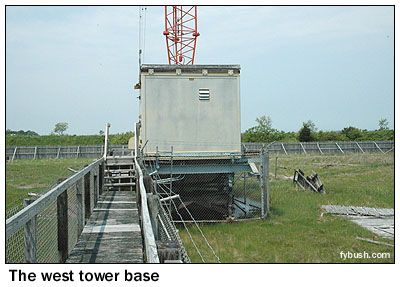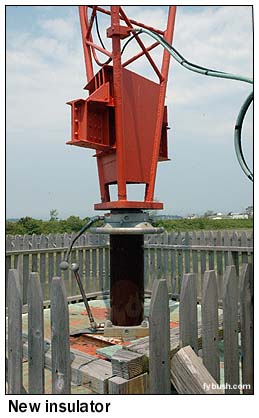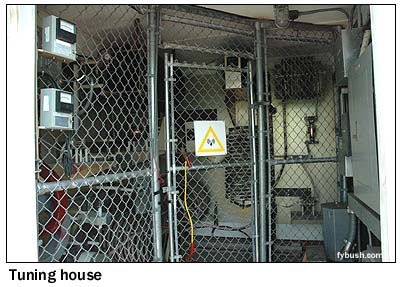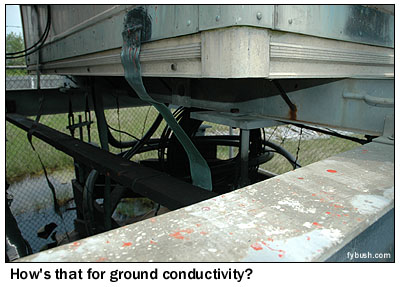
|
|

August 12 & 19, 2005
WBZ: 65 Years in Hull, part II
By SCOTT FYBUSH
 In
our last installment of Tower Site of the Week, we took you inside
the building in Hull, Massachusetts that's housed the transmitters
of WBZ (1030) since the summer of 1940.
In
our last installment of Tower Site of the Week, we took you inside
the building in Hull, Massachusetts that's housed the transmitters
of WBZ (1030) since the summer of 1940.
This week, we head out the back door and down the catwalk that stretches over the swampy land behind the building and out to the two 520-foot towers that dominate the landscape in this part of the world.
These towers were half-wave on 990 kHz, the frequency WBZ used in 1940, and that makes them just a bit over half-wave - 188.5 degrees - and a bit more than a quarter-wave apart (93.6 degrees) on the 1030 kHz frequency that WBZ moved to in 1941. Those details aside, this is as basic a two-tower cardioid array as it gets.
What's not so basic is the process of dealing with the effects of six decades of salt air on these towers, and that's a challenge that the WBZ engineering staff faced a few years back when it came time to renovate the site.
 In an
ideal world, the aging towers would simply have been taken down
one at a time and replaced with new steel. But this is the 21st
century, and as at so many other sites in densely-populated areas,
the zoning challenges put in place by the town (not to mention
the environmental impact such a project would have had on this
wetland area) meant that if the original towers ever came down,
there would be almost no chance of putting them back up.
In an
ideal world, the aging towers would simply have been taken down
one at a time and replaced with new steel. But this is the 21st
century, and as at so many other sites in densely-populated areas,
the zoning challenges put in place by the town (not to mention
the environmental impact such a project would have had on this
wetland area) meant that if the original towers ever came down,
there would be almost no chance of putting them back up.
At the same time, WBZ still had to address the very real problem that the steel in the towers was in bad shape in some areas - and that's not even mentioning the 60 year old insulators at the base of each tower or the aging tuning networks.
Some of the nation's top engineering consultants were put to work on the problem, and here's the solution they arrived at: by replacing the existing two levels of guy wires on each tower (which didn't reach anywhere near the top of the towers) with five levels of guys, the towers could be stabilized against just about anything nature could throw at them.
Through much of 1999, WBZ operated from its 10 kW backup transmitter at its studio site in Boston's Allston neighborhood while the work proceeded out at Hull.
New base insulators were installed, and workers moved up and down each tower in tented enclosures to contain the lead paint that was released as each tower was carefully restored to stable condition. In effect, each tower was rebuilt in place, and by 2000 WBZ was back to full power from the rebuilt Hull site, complete with new tuning houses (replacing the old ones that had been directly beneath each tower.)
And speaking of those tuning houses - take a look at the photo below, showing the support frame that keeps each one elevated over the swamp below. It's hard to imagine much better ground systems than this one, which connects directly to the salt water of Massachusetts Bay.
 |
 |
It's a neat site - and it's now in stable condition to continue serving New England and far beyond for years to come.
It's almost here - ordering is now open for the brand-new 2006 Tower Site Calendar! Click here for ordering information!
- Previous Site of the Week: WBZ: 65 Years in Hull, part 1
- Next Week: WJTO, Bath, Maine
- Site of the Week INDEX!
- How can you help support Site of the Week? Click here!
- Submit your suggestions for a future Site of the Week!
